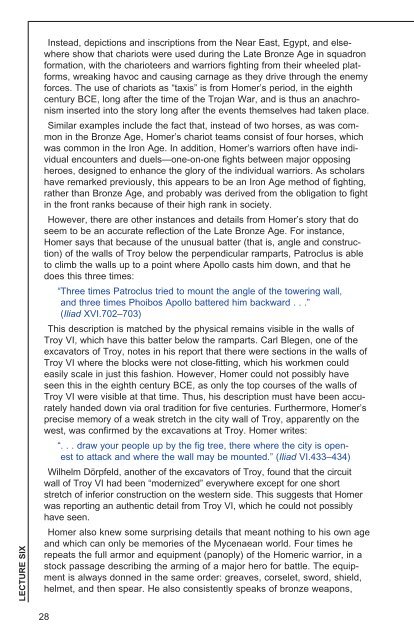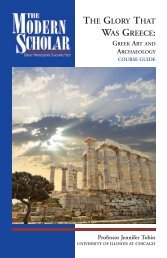The Trojan War in Homer and History - Recorded Books
The Trojan War in Homer and History - Recorded Books
The Trojan War in Homer and History - Recorded Books
Create successful ePaper yourself
Turn your PDF publications into a flip-book with our unique Google optimized e-Paper software.
LECTURE SIX<br />
Instead, depictions <strong>and</strong> <strong>in</strong>scriptions from the Near East, Egypt, <strong>and</strong> elsewhere<br />
show that chariots were used dur<strong>in</strong>g the Late Bronze Age <strong>in</strong> squadron<br />
formation, with the charioteers <strong>and</strong> warriors fight<strong>in</strong>g from their wheeled platforms,<br />
wreak<strong>in</strong>g havoc <strong>and</strong> caus<strong>in</strong>g carnage as they drive through the enemy<br />
forces. <strong>The</strong> use of chariots as “taxis” is from <strong>Homer</strong>’s period, <strong>in</strong> the eighth<br />
century BCE, long after the time of the <strong>Trojan</strong> <strong>War</strong>, <strong>and</strong> is thus an anachronism<br />
<strong>in</strong>serted <strong>in</strong>to the story long after the events themselves had taken place.<br />
Similar examples <strong>in</strong>clude the fact that, <strong>in</strong>stead of two horses, as was common<br />
<strong>in</strong> the Bronze Age, <strong>Homer</strong>’s chariot teams consist of four horses, which<br />
was common <strong>in</strong> the Iron Age. In addition, <strong>Homer</strong>’s warriors often have <strong>in</strong>dividual<br />
encounters <strong>and</strong> duels—one-on-one fights between major oppos<strong>in</strong>g<br />
heroes, designed to enhance the glory of the <strong>in</strong>dividual warriors. As scholars<br />
have remarked previously, this appears to be an Iron Age method of fight<strong>in</strong>g,<br />
rather than Bronze Age, <strong>and</strong> probably was derived from the obligation to fight<br />
<strong>in</strong> the front ranks because of their high rank <strong>in</strong> society.<br />
However, there are other <strong>in</strong>stances <strong>and</strong> details from <strong>Homer</strong>’s story that do<br />
seem to be an accurate reflection of the Late Bronze Age. For <strong>in</strong>stance,<br />
<strong>Homer</strong> says that because of the unusual batter (that is, angle <strong>and</strong> construction)<br />
of the walls of Troy below the perpendicular ramparts, Patroclus is able<br />
to climb the walls up to a po<strong>in</strong>t where Apollo casts him down, <strong>and</strong> that he<br />
does this three times:<br />
“Three times Patroclus tried to mount the angle of the tower<strong>in</strong>g wall,<br />
<strong>and</strong> three times Phoibos Apollo battered him backward . . .”<br />
(Iliad XVI.702–703)<br />
This description is matched by the physical rema<strong>in</strong>s visible <strong>in</strong> the walls of<br />
Troy VI, which have this batter below the ramparts. Carl Blegen, one of the<br />
excavators of Troy, notes <strong>in</strong> his report that there were sections <strong>in</strong> the walls of<br />
Troy VI where the blocks were not close-fitt<strong>in</strong>g, which his workmen could<br />
easily scale <strong>in</strong> just this fashion. However, <strong>Homer</strong> could not possibly have<br />
seen this <strong>in</strong> the eighth century BCE, as only the top courses of the walls of<br />
Troy VI were visible at that time. Thus, his description must have been accurately<br />
h<strong>and</strong>ed down via oral tradition for five centuries. Furthermore, <strong>Homer</strong>’s<br />
precise memory of a weak stretch <strong>in</strong> the city wall of Troy, apparently on the<br />
west, was confirmed by the excavations at Troy. <strong>Homer</strong> writes:<br />
“. . . draw your people up by the fig tree, there where the city is openest<br />
to attack <strong>and</strong> where the wall may be mounted.” (Iliad VI.433–434)<br />
Wilhelm Dörpfeld, another of the excavators of Troy, found that the circuit<br />
wall of Troy VI had been “modernized” everywhere except for one short<br />
stretch of <strong>in</strong>ferior construction on the western side. This suggests that <strong>Homer</strong><br />
was report<strong>in</strong>g an authentic detail from Troy VI, which he could not possibly<br />
have seen.<br />
<strong>Homer</strong> also knew some surpris<strong>in</strong>g details that meant noth<strong>in</strong>g to his own age<br />
<strong>and</strong> which can only be memories of the Mycenaean world. Four times he<br />
repeats the full armor <strong>and</strong> equipment (panoply) of the <strong>Homer</strong>ic warrior, <strong>in</strong> a<br />
stock passage describ<strong>in</strong>g the arm<strong>in</strong>g of a major hero for battle. <strong>The</strong> equipment<br />
is always donned <strong>in</strong> the same order: greaves, corselet, sword, shield,<br />
helmet, <strong>and</strong> then spear. He also consistently speaks of bronze weapons,<br />
28






